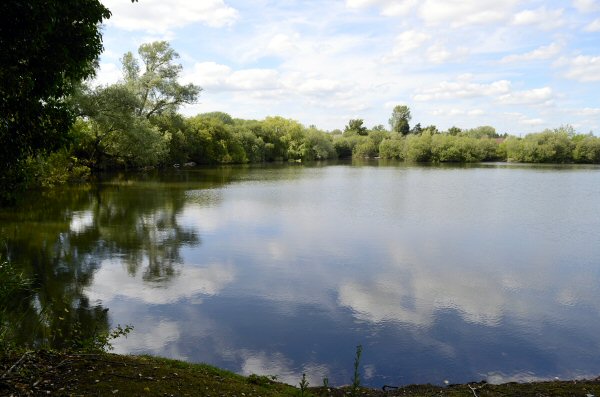Of Pongs and Birdmen (a carp angler's progress)
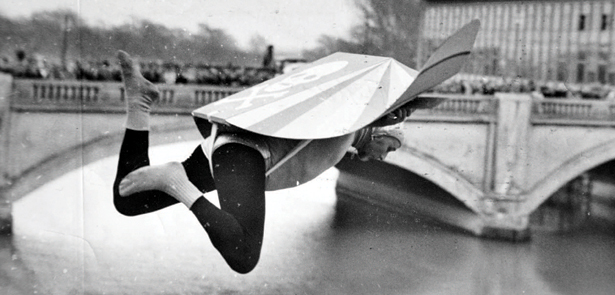
"The
Peterborough Pong" - the overpowering, sweet and sickly smell that used
to hang over the city when the sugar-beet factory was in operation.
"Walter the Birdman" - The late Walter Cornelius, eccentric
amateur strongman, whose attempts to fly over the River
Nene with home made wings attracted the attentions of the national media.
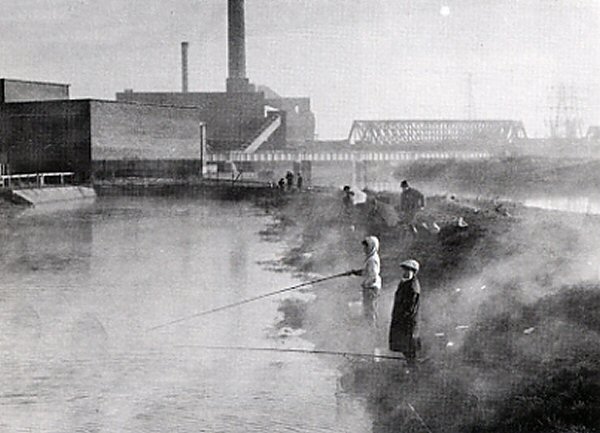
The Peterborough Electricity Cut in the Sixties - mud, rats and mist
Once upon a time, long ago in a far away universe, England was a country in which snow fell in winter and anglers in trench oats and wellington boots, sat on wicker baskets, pulled their collars up against the biting winds, drinking dark, stewed tea from tartan flasks. In a place called Peterborough, now known as the arson capital of the East Midlands, but then famous for Walter the Birdman and the Peterborough Pong, a younger version of myself occasionally ventured to the Electricity Cut in search of the mythical monsters within its steaming, mucky, murky waters.
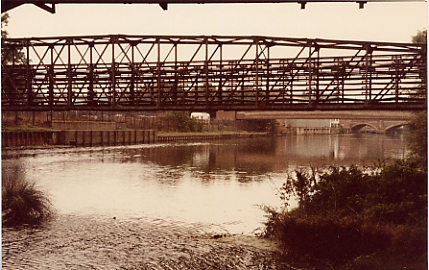
A town centre hotspot. Walter's take-off point was
beside the distant bridge
On icy January mornings, strange, frosted apparitions huddled under mountains of blankets, sporting the fashionable footwear of the times; oversized wellingtons, slit at the front and laced to accommodate feet encased in the baby-gro type legs of padded tanksuits. Once, on such a morning, with my feet solidified inside my wellies, the sight of Peter Harvey, dressed as above, recumbent on a white and frozen riverbank, drinking cold milk straight from the bottle, almost made me lose the will to live.
Often I would stand there for hours, watching my Fairy Liquid bottle top indicators twitching incessantly, as the rampant bleak shoals demolished my breadflake, like piranha savaging a fresh, bloody corpse, I would grow numb with the cold, heave my wellies out of the sucking black mud and head despondently for home. How my primitive and unsuitable tackle would have coped with even a medium sized monster was never put to the test.

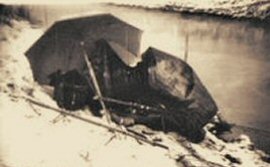
Set up for February all-nighters on the Electricity Cut in the late Sixties
During the early 1970s, one of the few waters holding carp within cycling distance of Bourne, was the four-acre Maxey No.1 Pit. With the exception of Chris Yates, who is quite mad, when was the last time you saw anyone straining against the wind on a pushbike overloaded with fishing tackle? Looking back on it now, I find it incredible that I would even contemplate the madness of the ten-mile bike ride to Maxey. Apart from the sheer physical effort, there was also the additional psychological trauma of clattering past the girls in the town centre whilst wearing my special “fishing clothes”, resulting in the loss of whatever personal dignity I may have once possessed. Undertaken in all weathers, with a rod holdall balanced on the handlebars and everything else on a rickety bike rack that was always coming unscrewed, the wisdom and practicality of this weekly endurance test was never questioned. After a season of fighting the whiplash fen winds that tried continuously to propel both me and my distinctly un-streamlined contraption into the roadside ditches, I must have had sinews of steel and lungs like bellows; I wonder what went wrong?
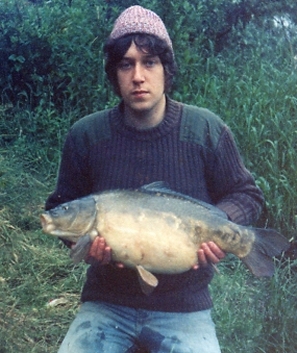
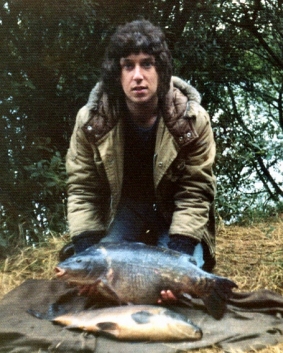
A 15lb mirror from Maxey in the 1970s
I experienced the entire evolution of modern carp fishing during my time at Maxey. Every item of tackle had to obey the official, ultra-cult design guidelines of what would now be referred to as minimalist chic. I bought fibreglass blanks and equipped them with hardchrome rings and Fuji snaplock reel seats. My one concession to decadence was in the abbreviated red leather handles, which had been made by cutting a big square into strips, then binding it around the blank, tennis racket style. My dad wasn’t too pleased though, as he’d just bought it for covering a stool. A mate of mine went even further in the search for credibility, by stripping the immaculate finish from his new Bruce & Walker Mk IV’s, and painting them a dull matt-green. Reels, inevitably, were Mitchell 300s and the line was 11lb Sylcast, as Rod Hutchinson said you could tow oil rigs with it.
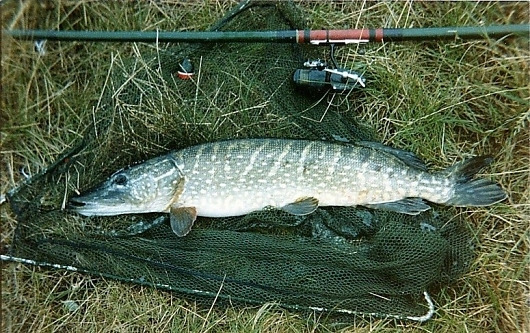
SS6 rods, with Fuji reel seats and red leather nicked from my Dad's shed
I anchored floating crust, made specials from cat food and milk powder, acquired my first bag of Red Slyme, flayed away at twitchers, even fished in winter, (for a few hours on nice days), all with moderate results. Finally, one fateful weekend a secretive group of Lincoln anglers caught more fish in a week than the rest of us had caught in a season. The sweetcorn era had arrived and our previous efforts were suddenly made to look ridiculous. Casting to the carp bubbles with floatfished sweetcorn in the early morning mist, I could often put four mirrors on the bank before 9am. Averaging about fourteen and a half pounds, this was superb fishing for the time and produced seasonal averages to rival that with improved tackle and methods, I often struggle to achieve even now.
The legendary Maxey No.1 - at one time one of of only a small number of carp waters in Lincs
PART 2 - EXPLORING THE MIDDLE NENE
In the Eighties, I spent the occasional day or night on the North Bank of the Nene, usually during the hottest days of the summer when the local pits had switched off. This was mainly for a change of scenery as I never really expected a run, my philosophy being that the fish I failed to catch would be bigger than those I failed to catch elsewhere. I hope you were paying attention there, and noticed a literary first in the unique connection between the words "North Bank", and "scenery". At the time, it was difficult to imagine the word "carp" ever being connected either, but I dozed in the sun, sometimes posing as a serious carp angler, while the horse-flies battled it out for prime positions on my veins. I think I was secretly hoping for fate to intervene, or perhaps to catch sight of a monster that would shake me out of my lethargy and inspire a more serious attempt at a later date.
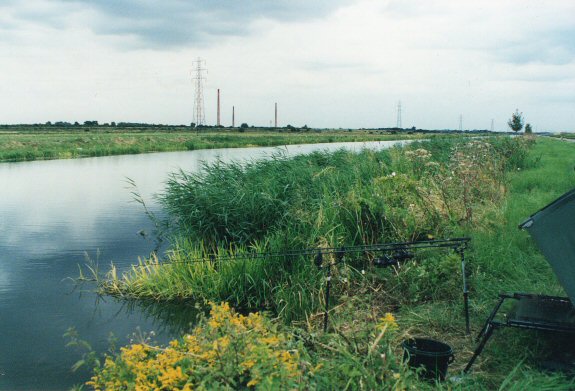
The North Bank in the Noughties- you'd need a machete and flame thrower to fish it now
Many years later, I had still not been seriously inspired, until a series of fruitless sessions on the Trent made me think that the same amount of time spent on the Nene would have been at least as productive, and due to escalating fuel prices, quite a lot cheaper. At this time, there were occasional reports trickling into the weeklies, and even a few magazine articles, suggesting that a few optimistic or deranged individuals were achieving results on the Nene that seemed to make it worth at least a bit of a dabble. Most of the reports tended to concentrate on the area close to the Peterborough town bridges, (for serious masochists only), and several unspecified areas, which could have been anywhere between Peterborough and Oundle. Most of the photographs gave few clues, but I managed to match one or two background pylons with those marked on the OS map.
By this time I had been joined by Rob the born again carper, who went for an overnight session near Wansford and bagged a twenty at the first attempt. The main problem with this area was that amount of litter, including beer cans, bottles and, shall we say, certain other items of a social nature, suggested that this was a popular stop off point for late night ravers. It was also close to a notorious public convenience, frequented by shifty looking gentlemen who seemed to find inordinate pleasure in their continual, creepy, circular tours of the surrounding bushes. Deciding that this was too far removed from the spirit of Mr.Crabtree, (in spite of any slanderous rumours to the contrary), I determined that my carping campaign would be carried out in more peaceful surroundings.
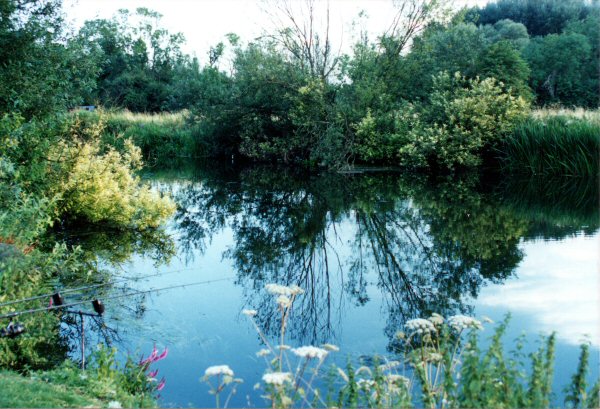
The picturesque Nene at Sutton, safely downstream of the usavoury picnic
area
My main priorities were seclusion, picturesque surroundings and hopefully, a few carp thrown in for good measure, so I studied the map to find somewhere a little bit more off the beaten track. This may seem a strange order of priorities to some, but I like to absorb the atmosphere when I am fishing; even the promise of a big carp does not compensate for misery of litter-strewn surroundings, roaring traffic, barking dogs, and stark raving, barking mad members of the general public. With this in mind, I managed to find a nearby stretch showing few signs of recent interference, a good distance from the road and sufficiently overgrown to lessen the chance of a sudden invasion by match anglers. The boats, although few in number, are unavoidable and seem ridiculously intrusive in such intimate surroundings. Some of these inland cruisers are almost wide enough to scrape each bank on some stretches, but luckily they are rarely a problem after sunset and disturb anglers far more than the fish. If you think your temperament isn't compatible with the peaceful acceptance of this, you are advised to fish elsewhere.

Mr Crabtree Goes Fisting - I'd advise against night fishing near the Wansford lay-by toilets
The chosen swim was on an S bend and thoroughly Crabtree compatible, (in the traditional sense). The river flowed dark, silent and mysterious between the lilypads, framed by the overhanging trees and bushes, which trailed their sheltering branches into the water. I made a few trial casts down the swim with a one ounce lead, testing for snags and estimating the depth, which seemed to average about six or seven feet. Finding no submerged horrors, I baited an area close to each bank with a scattering of hemp, sweetcorn and chickpeas, following up with a few broken boilies. The weather was still, warm and overcast, but without the threat of rain; to sum up. it was the carper's equivalent of a mayfly hatch during duffer's fortnight, during which the fish queue up to be caught. If no carp were to show up in such conditions, then they didn't exist, and I would move on to another area. I sat back contentedly, watching the hordes of small fry taking invisible creatures from the surface film and then two kingfishers, chasing each other noisily up and down the river. Before the light had even begun to fade a rattle on the far bank rod produced a chub of about three pounds. Shortly afterwards, a twitchy take on the near side rod indicated the first of many bream.
An hour into darkness and a screaming take on the far bank rod indicated that this was no bream. Luckily it decided to hurtle upstream, rather than power off into the uncharted territory through the pads and beyond the bend: I hadn't encountered fast and furious action in such confined quarters, since college days. It changed speed and direction at a rate that my remaining brain cells struggled to compute, but eventually, with the torch clamped in my mouth and dribbling profusely, I steered the fish into an outstretched landing net. A great psychological barrier had been lifted; my first "proper" Nene carp was on the bank. A further surprise was in store, for the glistening mirror carp had a silvery sheen, revealing it to be an escaped qhostie, probably released from one of the nearby pits in the extensive floods of the previous winter. A quick weighing in the Woolies garden bag showed a weight of 11lbs 12ozs, and at that moment I was a very happy angler - and it was still only 10.30pm.
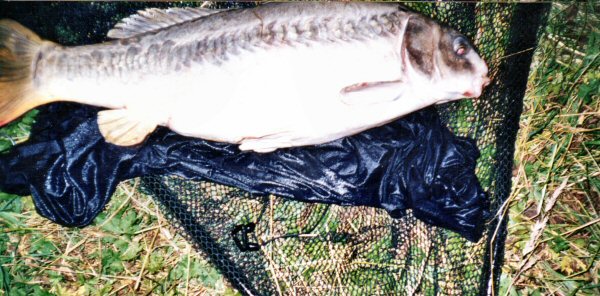
A hastily taken shot of the ghost carp from Sutton
Unbelievably after all the commotion, I returned to my rods after returning the fish, only to find that a take on the nearside rod had produced yet another bream. Within half an hour I was in again. The fight was a rod-wrenching repeat performance, making the line whine and the clutch scream. The rapid turns of speed were almost trout-like, with the demented fish hurtling around the swim on its mission to uproot every form of plant life it encountered, but soon the huge boils in front of me signified that the fish was almost ready for netting. As another carp was unhooked and weighed, the scales revealed a very pleasing 14lbs 10ozs, an immaculate common. By 3.20am, I had landed another, smaller common, then lost another powerful fish that refused to conform and sped off downstream through the pads. I had continued to catch chub and bream at regular intervals and had now lost count of the numbers caught.
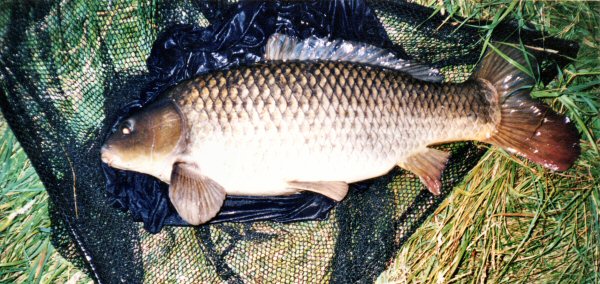
Throughout the night the air had remained comfortably warm, with not a breath of wind. The moths and mosquitoes had been out in force and the bats had continued to give false beeps on the alarms as they bumped into the line. This is a phenomenon often encountered on the Trent at dusk, when the rods are pointed skywards to keep the line out of the current. I have come to regard this as a signal of action to come, possibly because the airborne insects tend to fly low over the water in the low air pressure conditions that are favourable to angling. For whatever reason, I no longer resent these continual false alarms, tending to feel positively encouraged by them. As soon as the first signs of light appeared the action ceased, the only activity remaining being that of the small fry dappling the surface and the young perch noisily perfecting their hunting skills. Subsequent visits in less ideal conditions produced chub, but few bream and no carp. I wasn't too upset as I am reluctant to over-fish these small swims anyway, but encouraged by my success, I decided that I was ready to try something a little more serious.
